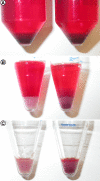Matrix-assisted laser desorption ionization-time of flight mass spectrometry for direct bacterial identification from positive blood culture pellets
- PMID: 20164269
- PMCID: PMC2849571
- DOI: 10.1128/JCM.01780-09
Matrix-assisted laser desorption ionization-time of flight mass spectrometry for direct bacterial identification from positive blood culture pellets
Abstract
An ammonium chloride erythrocyte-lysing procedure was used to prepare a bacterial pellet from positive blood cultures for direct matrix-assisted laser desorption-ionization time of flight (MALDI-TOF) mass spectrometry analysis. Identification was obtained for 78.7% of the pellets tested. Moreover, 99% of the MALDI-TOF identifications were congruent at the species level when considering valid scores. This fast and accurate method is promising.
Figures

Similar articles
-
Microorganisms direct identification from blood culture by matrix-assisted laser desorption/ionization time-of-flight mass spectrometry.Clin Microbiol Infect. 2011 Apr;17(4):546-51. doi: 10.1111/j.1469-0691.2010.03257.x. Clin Microbiol Infect. 2011. PMID: 20456452
-
Use of MALDI-TOF MS technique for rapid identification of bacteria from positive blood cultures.Indian J Med Microbiol. 2014 Oct-Dec;32(4):419-22. doi: 10.4103/0255-0857.142261. Indian J Med Microbiol. 2014. PMID: 25297028
-
Rapid identification of bacteria in positive blood culture broths by matrix-assisted laser desorption ionization-time of flight mass spectrometry.J Clin Microbiol. 2010 Feb;48(2):444-7. doi: 10.1128/JCM.01541-09. Epub 2009 Dec 2. J Clin Microbiol. 2010. PMID: 19955282 Free PMC article.
-
Detection of microorganisms in blood specimens using matrix-assisted laser desorption ionization time-of-flight mass spectrometry: a review.Clin Microbiol Infect. 2010 Nov;16(11):1620-5. doi: 10.1111/j.1469-0691.2010.03290.x. Clin Microbiol Infect. 2010. PMID: 20545958 Review.
-
Blood culture-based diagnosis of bacteraemia: state of the art.Clin Microbiol Infect. 2015 Apr;21(4):313-22. doi: 10.1016/j.cmi.2015.01.003. Epub 2015 Jan 16. Clin Microbiol Infect. 2015. PMID: 25753137 Review.
Cited by
-
MALDI-TOF MS Versus VITEK®2: Comparison of Systems for the Identification of Microorganisms Responsible for Bacteremia.Curr Microbiol. 2016 Dec;73(6):843-850. doi: 10.1007/s00284-016-1121-x. Epub 2016 Sep 12. Curr Microbiol. 2016. PMID: 27620383 Free PMC article.
-
Same day identification and full panel antimicrobial susceptibility testing of bacteria from positive blood culture bottles made possible by a combined lysis-filtration method with MALDI-TOF VITEK mass spectrometry and the VITEK2 system.PLoS One. 2014 Feb 14;9(2):e87870. doi: 10.1371/journal.pone.0087870. eCollection 2014. PLoS One. 2014. PMID: 24551067 Free PMC article.
-
Novel, improved sample preparation for rapid, direct identification from positive blood cultures using matrix-assisted laser desorption/ionization time-of-flight (MALDI-TOF) mass spectrometry.J Mol Diagn. 2011 Nov;13(6):701-6. doi: 10.1016/j.jmoldx.2011.07.004. Epub 2011 Sep 1. J Mol Diagn. 2011. PMID: 21889611 Free PMC article.
-
Potential Impact of Flow Cytometry Antimicrobial Susceptibility Testing on the Clinical Management of Gram-Negative Bacteremia Using the FASTinov® Kit.Front Microbiol. 2017 Dec 12;8:2455. doi: 10.3389/fmicb.2017.02455. eCollection 2017. Front Microbiol. 2017. PMID: 29312169 Free PMC article.
-
MALDI-TOF mass spectrometry: an emerging technology for microbial identification and diagnosis.Front Microbiol. 2015 Aug 5;6:791. doi: 10.3389/fmicb.2015.00791. eCollection 2015. Front Microbiol. 2015. PMID: 26300860 Free PMC article. Review.
References
-
- Conway, G. C., S. C. Smole, D. A. Sarracino, R. D. Arbeit, and P. E. Leopold. 2001. Phyloproteomics: species identification of Enterobacteriaceae using matrix-assisted laser desorption/ionization time-of-flight mass spectrometry. J. Mol. Microbiol. Biotechnol. 3:103-112. - PubMed
-
- Hsieh, S. Y., C. L. Tseng, Y. S. Lee, A. J. Kuo, C. F. Sun, Y. H. Lin, and J. K. Chen. 2008. Highly efficient classification and identification of human pathogenic bacteria by MALDI-TOF MS. Mol. Cell. Proteomics 7:448-456. - PubMed
-
- Mellmann, A., J. Cloud, T. Maier, U. Keckevoet, I. Ramminger, P. Iwen, J. Dunn, G. Hall, D. Wilson, P. Lasala, M. Kostrzewa, and D. Harmsen. 2008. Evaluation of matrix-assisted laser desorption ionization-time-of-flight mass spectrometry in comparison to 16S rRNA gene sequencing for species identification of nonfermenting bacteria. J. Clin. Microbiol. 46:1946-1954. - PMC - PubMed
Publication types
MeSH terms
LinkOut - more resources
Full Text Sources
Other Literature Sources
Medical

